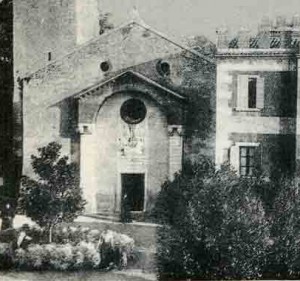Church of Saint Andrea
Church of Saint Andrea is located on the slopes of Mount Moscal, in the homonymous basin where the villa is located
Church of Saint Andrea and the building next door is the oldest part of the complex, which should be from the 11th century, as Orti Manara states, which describes it: The hospice is modest, and the church, which looks like a building of the eleventh century, or at that time, is proportionate to it.. It has three naves. Its length up to the choir is 18.50 meters; the niche is 4.10 meters long. It is 10.95 meters wide, 7.80 meters high in the aisle of half meters. The arches in the center that divide the naves, are four supported by square pillars. Above the niche of the altar, I saw a small round window. The facade is very simple. The bell tower is square”.
The church also appears in documents that speak of its donation in 807, together with its jurisdiction over the fields, villas and inhabitants of the area to the church of San Zeno di Verona, by King Pipino (or Carlomanno 773 or 777 – 810); Mor, Canobio and Moscardo speak about it. The first document, however, is certainly a diploma of the King of Italy Henry II of 1014, followed by one of Henry III of 1047, by that of Frederick I of 1163 and of Urban III of 1187. Together with the church of Sant’Andrea there was, since the time of its foundation, a Benedictine monastery, from the area of San Zeno di Verona; this community was subject to a prior, sent by Verona, to administer the assets and there is various documentation of which some dating back to 1287, to 1389 and later, where it is mentioned:” the monastery and the chapter have used these rights for so long that there is no memory of man that can affirm the opposite”. In 1425, following a religious crisis in the monastery of San Zeno di Verona, the history of the church with its priory is declining, but the monks of San Zeno must continue to take care of it so much that, in the second half of the 15th century, the church of Sant’Andrea is rebuilt. At the beginning of the seventeenth century the roof of the building was redone, the sides of the side aisles, which had to be lower than the central one, are raised and brought to the same level; moreover many frescos are executed by Paolo Ligozzi, then eliminated in the course of history for an attempt to bring the church back to its original state. towards the end of the seventeenth century the bell tower was built. The rights of the church of San Zeno on Sant’Andrea ceased in 1771 and subsequently the complex became property of the state property; the entire area is then purchased by Jacopo Bottagisio. The Bottagisio family modifies the complex by adding merlons, a tower containing a staircase and altering the proportions between the church and the building next to it; subsequently however there have been some works of restoration of the previous lines with the removal of most of the Bottagisio modifications.

